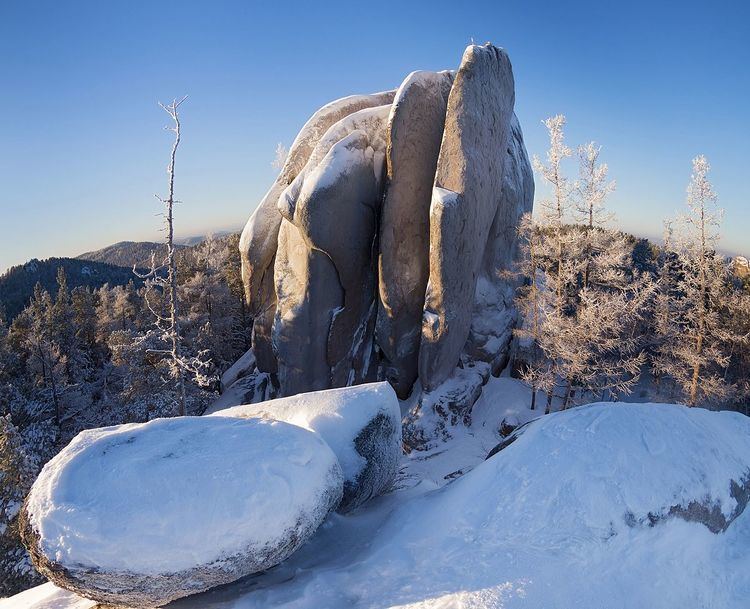Nearest city Krasnoyarsk | Area 471.5 km² | |
 | ||
Location Krasnoyarsk krai, Russia Address Krasnoyarsk, Krasnoyarsk Krai, Russia, 660071 Similar Bobrovy Log, Sayan Mountains, Paraskeva Pyatnitsa Chapel, Ergaki, Lena Pillars | ||
Stolby Nature Sanctuary (Russian:запове́дник «Столбы́»), (in English, "The Pillars") is a Russian strict ecological reserve located 10 km south of the city of Krasnoyarsk, on the northwestern spurs of the Eastern Sayan Mountains. The site is known for its dramatic complexes of rocks; 3.5% of the reserve is open to hikers seeking to visit and climb the rocks. Over 200,000 visitors per year are recorded. The park was founded in 1925 by citizens the picturesque Syenite Buttes and surrounding rocky landscape. The park’s area is 47,219 hectares. Stolby has been nominated to be on the list of UNESCO World Heritage Sites.
Contents
- Kraskoyarsk stolby nature sanctuary
- Topography
- Flora and fauna
- Ecotourism and access
- History of explorations
- References
Kraskoyarsk stolby nature sanctuary
Topography
The reserve's natural borders are the Bazaikha River, a right tributary of the Yenisei River, in the northeast. The Mana River and Bolshaia Slizneva ("Big Slime") River are in the south and southwest. The area borders upon the city of Krasnoyarsk from the northeast. Area is divided into two parts. The first is straight Stolby, which are opened for tourists. The second is "Wild Stolby", which are located in the depths of the reserve, where access is restricted.
Flora and fauna
Flora of national reserves includes about 740 vascular plants and 260 kinds of mosses. Fir taiga, which is typical for the midlands of the Eastern Sayan, prevails. 290 types of vertebrates are revealed on the territory of sanctuary. Fauna has a pronounced taiga aspect (red-backed mouse, sable, Siberian musk deer, hazel grouse and others) with the inclusion of forest-steppe animals (Siberian roe deer, steppe polecat, long-tailed ground squirrel and others)
Also, there are species from The Red Book of Russia:
Ecotourism and access
Visitors are able to get to the boundary by a city bus. Main attraction of the reserve is the rocks - the general name of the rocks is Stolby, although all of them and even some stones have their own names. Inhabitants of Krasnoyarsk have been visiting Stolby for more than 150 years for sport and adventure holidays.
Three districts are accessible to tourists:
History of explorations
Daniel Gottlieb Messerschmidt visited the Stolby in 1720 – 1727. He stayed triply in Krasnoyarsk in the time of his exploration of Siberia, which continued seven years.
Vitus Bering visited it in 1733-1734.
In 1735 Stolby were visited by participants of overland team of the Second Kamchatka Expedition, including naturalists Johann Georg Gmelin and his assistant Stepan Krasheninnikov.
In 1771-1773, eminent explorer of Siberia professor of natural history Peter Simon Pallas visited the Stolby. He lived about a year in Krasnoyarsk and work on monographs "Journey in various provinces of the Russian Empire," "Description of plants of the Russian state," "Russian-Asian zoogeography."
The gold rush started in Siberia in the 1830s. Gold was mined in the Stolby. "Royev Ruchey" (Eng. "Scooped Brook") was named so because of the activities of miners.
In 1833 furs of 67 sables, foxes and 43 to thousands of skins of other animals were extracted in the "Stolby"
In 1870 and 1880s, teacher of the Krasnoyarsk gymnasium Ivan Savenkov started to organize school trips to the "Pillars". Savenkov wrote a topographical description of the suburbs of Krasnoyarsk, which would be starting paper for all entry-level geologists of Siberia. He published it in 1886.
Yenisei provincial executive committee declared this earth location to be a natural reserve "Stolby" by the resolution dated June 30, 1925.
In 1947 married couple Yelena Krutovskaya and James Dulkeyt set up a reserve for keeping of animals injured by poachers. It was in the Reserve's region for tourist and excursion .
From the late 1940s to the beginning of the 21st century, 16 collections of scientific papers were published. The effect of air pollution and recreational using on taiga ecosystems is investigated. One of the researchers of "Pillars", Ivan Beljak, was author of several books about the area.
In 2000 the animal reserve became the basis of the zoo "Royev Ruchey".
